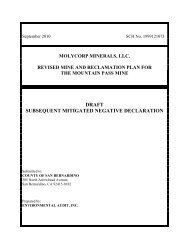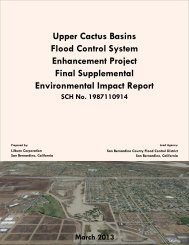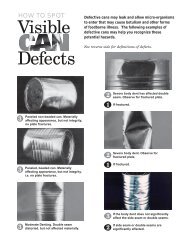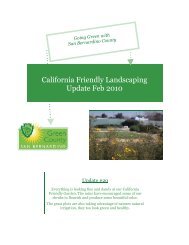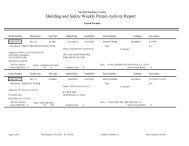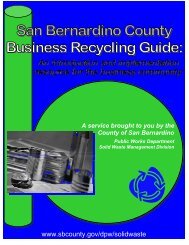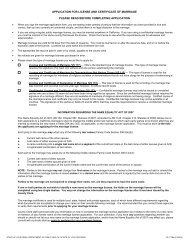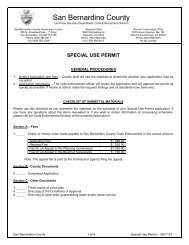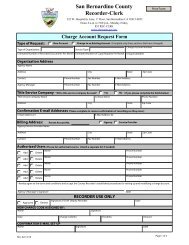Lytle Creek Community Plan - San Bernardino County
Lytle Creek Community Plan - San Bernardino County
Lytle Creek Community Plan - San Bernardino County
You also want an ePaper? Increase the reach of your titles
YUMPU automatically turns print PDFs into web optimized ePapers that Google loves.
<strong>County</strong> StaffJulie Rynerson Rock, AICP, Director, Land Use Services DepartmentRandy Scott, AICP, Deputy Director, Advance <strong>Plan</strong>ningJim Squire, AICP, Supervising <strong>Plan</strong>nerCarrie Hyke, AICP, Supervising <strong>Plan</strong>nerDave Prusch, AICP, Senior Associate <strong>Plan</strong>nerRon Matyas, Senior Associate <strong>Plan</strong>nerMatt Slowik, REHS, Senior Associate <strong>Plan</strong>nerConsultants to the <strong>County</strong>URS CorporationFrank Wein, DPDS, FAICP, Project ManagerJeff Rice, AICP, Assistant Project ManagerBrian Smith, AICP, Environmental ManagerKavita Mehta, Urban and Environmental <strong>Plan</strong>nerCynthia Wilson, Environmental <strong>Plan</strong>nerMari Piantka, Senior <strong>Plan</strong>nerMichael Greene, INCE Bd. Cert., Senior Project ScientistJoseph Czech, Senior Project EngineerJun Wang, Senior Water Resources EngineerCynthia Gabaldon, Senior EngineerVeronica Seyde, Senior ScientistTom Herzog, Senior BiologistBryon Bass, Senior ArchaeologistPaul Nguyen, Senior Air Quality ScientistChris Goetz, Senior Project GeologistJerry Zimmerle, Principal EngineerJoe Devoy, GIS SpecialistMatt Eimers, GIS AnalystWendy Lamont, Word ProcessorWayne Lim, Senior Graphic DesignerHogle-Ireland, Inc.Paul Ireland, PartnerMike Thiele, AICP, PrincipalKimiko Lizardi, Project ManagerRon Pflugrath, AICPJacobson and WackBruce Jacobson, AICP, PrincipalRBF ConsultingLaura Stearns, <strong>Plan</strong>nerStanley R. Hoffman Associates, Inc.Stanley R. Hoffman, FAICP, PresidentDebbie L. Lawrence, AICP, Project ManagerBravishwar Mallavarapu, <strong>Plan</strong>nerISMS, Inc.Doug Mende, Vice PresidentEconomics Politics, Inc.John Husing, Vice PresidentApril 12, 2007 3
Meyer, Mohaddes AssociatesViggen Davidian, P.E, Project ManagerMatthew Simons, T.E., Senior Transportation EngineerAdolfo Ozaeta, Project EngineerYim Tse, Graphics TechnicianPsomasDan McCroskey, PLS, Project ManagerDuane HaselfeldSergio <strong>San</strong>chezMoore, Iacofano & Goltzman (MIG)Pat McLaughlin, Office ManagerEsmeralda Garcia, Project AssociateSpecial AcknowledgementsBill Postmus, Past First District Supervisor and Chairman of the BoardTheresa Kwappenberg, Past Third District <strong>Plan</strong>ning CommissionerMichael E. Hays, AICP, Past Director, Land Use Services DepartmentSam Gennawey, Past Project Manager for MIG4April 12, 2007
TABLE OF CONTENTSTABLE OF CONTENTS1 INTRODUCTION.................................................................................................................................................................. 7LC1.1 PURPOSE OF THE COMMUNITY PLAN .................................................................................................................... 7LC1.2 COMMUNITY BACKGROUND .................................................................................................................................... 7LC1.2.1 LOCATION .............................................................................................................................................................. 7LC1.2.2 HISTORY ................................................................................................................................................................. 7LC1.2.3 DESCRIPTION OF THE PLAN AREA ................................................................................................................... 11LC1.3 COMMUNITY CHARACTER....................................................................................................................................... 11LC1.3.1 UNIQUE CHARACTERISTICS ............................................................................................................................... 11LC1.3.2 ISSUES AND CONCERNS...................................................................................................................................... 11LC1.3.3 COMMUNITY PRIORITIES.................................................................................................................................... 122 LAND USE.................................................................................................................................................................................... 13LC2.1 LAND USE - INTRODUCTION.................................................................................................................................. 13LC2.2 GOALS AND POLICIES .............................................................................................................................................. 193 CIRCULATION AND INFRASTRUCTURE ........................................................................................................................ 21LC3.1 INTRODUCTION........................................................................................................................................................ 21LC3.2 CIRCULATION – INTRODUCTION........................................................................................................................... 21LC3.3 GOALS AND POLICIES - CIRCULATION.................................................................................................................. 25LC3.4 INFRASTRUCTURE - INTRODUCTION...................................................................................................................... 27LC3.5 GOALS AND POLICIES - INFRASTRUCTURE........................................................................................................... 354 HOUSING..................................................................................................................................................................................... 375 CONSERVATION....................................................................................................................................................................... 39LC5.1 INTRODUCTION ........................................................................................................................................................ 39LC5.2 GOALS AND POLICIES............................................................................................................................................... 396 OPEN SPACE............................................................................................................................................................................... 41LC6.1 INTRODUCTION........................................................................................................................................................ 41LC6.2 GOALS AND POLICIES ............................................................................................................................................. 457 NOISE ............................................................................................................................................................................................ 478 SAFETY ......................................................................................................................................................................................... 49LC8.1 INTRODUCTION ........................................................................................................................................................ 49LC8.2 GOALS AND POLICIES............................................................................................................................................... 569 ECONOMIC DEVELOPMENT .............................................................................................................................................. 59LC9.1 INTRODUCTION........................................................................................................................................................ 59LC9.2 GOALS AND POLICIES............................................................................................................................................... 5910 IMPLEMENTATION............................................................................................................................................................... 61LIST OF FIGURESFIGURE 1-1, VICINITY/REGIONAL CONTEXT ................................................................................................................. 9FIGURE 2-1, LAND USE POLICY ............................................................................................................................................ 15FIGURE 3-1, CIRCULATION ..................................................................................................................................................... 23FIGURE 3-2, WATER DISTRICTS............................................................................................................................................. 29FIGURE 3-3, WASTEWATER SYSTEM ................................................................................................................................... 33FIGURE 6-1, JURISDICTIONAL CONTROL......................................................................................................................... 43FIGURE 8-1, FIRE DISTRICTS .................................................................................................................................................. 51FIGURE 8-2, FIRE STATIONS ................................................................................................................................................... 53April 12, 2007 5
INTRODUCTION1 INTRODUCTIONLC1.1PURPOSE OF THE COMMUNITY PLANThe primary purpose of the <strong>Lytle</strong> <strong>Creek</strong> <strong>Community</strong> <strong>Plan</strong> is to guide the future use and development of landwithin the <strong>Lytle</strong> <strong>Creek</strong> <strong>Community</strong> <strong>Plan</strong> area in a manner that preserves the character and independentidentity of the community. By setting goals and policies for the <strong>Lytle</strong> <strong>Creek</strong> community that are distinct fromthose applied countywide, the <strong>Community</strong> <strong>Plan</strong> outlines how the <strong>County</strong> of <strong>San</strong> <strong>Bernardino</strong> will manage andaddress growth while retaining the attributes that make <strong>Lytle</strong> <strong>Creek</strong> unique.<strong>Community</strong> plans focus on a particular region or community within the overall <strong>County</strong>’s General <strong>Plan</strong>. As anintegral part of the overall <strong>County</strong> General <strong>Plan</strong>, a community plan must be consistent with the General <strong>Plan</strong>.To facilitate consistency, the <strong>Lytle</strong> <strong>Creek</strong> <strong>Community</strong> <strong>Plan</strong> builds upon the goals and policies of each elementof the General <strong>Plan</strong>. However, to avoid repetition, those goals and policies defined within the overall General<strong>Plan</strong> that adequately address the conditions of the community will not be repeated in this or other communityplans. Instead, the policies that are included within the community plan should be regarded as refinements ofbroader General <strong>Plan</strong> goals and policies that have been customized to meet the specific needs or uniquecircumstances raised by the individual communities.LC1.2COMMUNITY BACKGROUNDLC1.2.1LOCATIONThe <strong>Lytle</strong> <strong>Creek</strong> plan area is roughly 6 square miles of unincorporated area. It is approximately 15 milesnorthwest of the City of <strong>San</strong> <strong>Bernardino</strong> and 10 miles from the cities of Fontana and Rialto. This smallremote community is located in a large southeast-trending canyon on the eastern portion of the <strong>San</strong> GabrielMountains completely within the boundaries of the <strong>San</strong> <strong>Bernardino</strong> National Forest. The plan area isaccessible by a single road off the I-15 (see Figure 1-1, Vicinity/Regional Context).LC1.2.2HISTORYMormons arrived in the valley in 1851, making camp at the mouth of a canyon with a creek, which flowedbriskly southeast through the canyon to the valley and the <strong>San</strong>ta Ana River. Overjoyed with the abundance ofwater, the dense growth of willows, cottonwoods and sycamores, and the mustard and wild oats that grew onthe hillsides, the settlers named the stream "<strong>Lytle</strong> <strong>Creek</strong>" after their leader, Captain Andrew <strong>Lytle</strong>. <strong>Lytle</strong> <strong>Creek</strong>Canyon has been a site for gold mining, farming, and recreation activities such as fishing, camping, picnicking,and hiking. <strong>Lytle</strong> <strong>Creek</strong> has been considered a recreational area since the early 1870s.April 12, 2007 7
INTRODUCTION[This page intentionally left blank]8April 12, 2007
INTRODUCTIONFigure 1-1, Vicinity/Regional ContextApril 12, 2007 9
INTRODUCTION[This page intentionally left blank]10April 12, 2007
INTRODUCTIONThe first subdivision of private lands into small lots began in the 1920s and was intended to support smallvacation cabins or tents and fire rings. Development of larger, permanent homes occurred during World WarII, however, the majority of the existing lot sizes are less than the current <strong>County</strong> standard. During the 1969floods, private development near the confluence of the North, Middle and South forks of <strong>Lytle</strong> <strong>Creek</strong>sustained severe damage. Historically, the <strong>Lytle</strong> <strong>Creek</strong> area has experienced heavy floods. The community iscurrently comprised of several small community clusters and inhabited by both full-time and part-timeresidents, and continues to attract recreational visitors.The original <strong>Lytle</strong> <strong>Creek</strong> <strong>Community</strong> <strong>Plan</strong> was adopted by the <strong>County</strong> in August 1981. The plan was intendedas a short-range plan to implement those portions of the General <strong>Plan</strong> that directly affected the community of<strong>Lytle</strong> <strong>Creek</strong>. The 1989 General <strong>Plan</strong> update proposed that comprehensive community plans be incorporatedinto the General <strong>Plan</strong> and Development Code. However, full incorporation into the General <strong>Plan</strong> was notcompleted due to budget and staff constraints. The Phase I Scoping of the 2006 General <strong>Plan</strong> updaterecommended that the <strong>Community</strong> <strong>Plan</strong> program be reinstated to help fulfill the need for developmentguidance within certain unique communities within the <strong>County</strong>. The <strong>Lytle</strong> <strong>Creek</strong> community was selected asone of 13 areas that would have a community plan prepared in conjunction with Phase II of the <strong>San</strong><strong>Bernardino</strong> <strong>County</strong> General <strong>Plan</strong> update.LC1.2.3DESCRIPTION OF THE PLAN AREA<strong>Lytle</strong> <strong>Creek</strong> is a perennial stream that runs through the community. The creek starts at the top of Mt. <strong>San</strong>Antonio, at an elevation of approximately 10,000 feet and flows eastward in three forks. The creek is thecenter of recreation activities within the area, with picnic and campground facilities near its banks. <strong>Lytle</strong> <strong>Creek</strong>is well known for its recreation opportunities; particularly its camping, fishing and hiking opportunities. Avariety of habitats can be found within the plan area, from chaparral, to lush riparian to high elevationconifers. The streams and wilderness areas in the canyon provide important habitats for an abundance ofplants and animals, including mountain lion, bear, badger, bighorn sheep, great horned owls, red-tailed hawk,coyotes, kangaroo rats, and a variety of birds.The <strong>Lytle</strong> <strong>Creek</strong> community overlies faults associated with the <strong>San</strong> Andreas – <strong>San</strong> Jacinto fault system. Mostof the faults are considered active and the area is subject to frequent earth tremors due to the close proximityof these major faults, including the <strong>San</strong> Jacinto fault, which runs along the length of the <strong>Lytle</strong> <strong>Creek</strong> Canyon.LC1.3LC1.3.1COMMUNITY CHARACTERUNIQUE CHARACTERISTICSThe <strong>Lytle</strong> <strong>Creek</strong> plan area is surrounded by the <strong>San</strong> <strong>Bernardino</strong> National Forest. The forest provides anabundance of recreation opportunities, including camping, hiking, fishing and nature viewing. Thecommunity shares many of the same rural characteristics of the National Forest: it is characterized by itsscenic resources and offers a unique refuge from the urban landscape. <strong>Lytle</strong> <strong>Creek</strong> is attractive to those whodesire to live in a mountain environment.LC1.3.2ISSUES AND CONCERNSA series of public meetings for the preparation of the plan were held in 2003 and 2004. The issues andconcerns identified in this section are based on input from those meetings. Several issues set <strong>Lytle</strong> <strong>Creek</strong> apartfrom other communities in the <strong>County</strong> suggesting that different strategies for future growth may beappropriate. Among these issues are: preservation of community character and safety.April 12, 2007 11
INTRODUCTIONA. PRESERVATION OF COMMUNITY CHARACTERThe residents of <strong>Lytle</strong> <strong>Creek</strong> have a strong desire to maintain the present mountain lifestyle,preferring development to be mainly residential. They are opposed to commercial development andwould like to keep tourism to a minimum. Preservation of natural resources and scenery is crucial tomaintaining the current community character in <strong>Lytle</strong> <strong>Creek</strong>. The community’s natural beauty ischaracterized by an abundance of open space, scenic vistas, natural vegetation and wildlife. As wasmentioned previously, the natural setting is a valuable characteristic of the community. Thecommunity itself shares many of the same rural, peaceful, scenic and environmentally appealingqualities. Residents have expressed the desire to retain their community character based on principlesof preservation and careful management of the natural environment.B. SAFETYThe issue of safety and protection from the damage that results from natural disasters such as fires,floods and earthquakes is a primary concern for residents.LC1.3.3COMMUNITY PRIORITIESThe community’s common priorities that have influenced the goals and policies included within this<strong>Community</strong> <strong>Plan</strong> are: (a) the environment, and (b) community character and quality of life.ENVIRONMENTA key consideration in developing this community plan has been acknowledging the potential impacts thatfuture development will have on the area’s natural resources. The goals and policies included in thiscommunity plan emphasize the protection of these natural resources, the integration of natural vegetation andopen space, and development designed to enhance the natural surroundings. In public workshops held todevelop the General <strong>Plan</strong> and this community plan, the public has identified the following principle planningissues and concerns to be addressed in the plan:A. Preservation of open spaceB. Conservation and protection of native wildlife and vegetationC. Visual and physical harmony between the natural and manmade environment.COMMUNITY CHARACTER AND QUALITY OF LIFEAs the <strong>Lytle</strong> <strong>Creek</strong> <strong>Community</strong> <strong>Plan</strong> area continues to experience growth and the effects of increased use ofits recreational opportunities by both residents and visitors, it will be imperative that adequate services andinfrastructure are provided, that all improvements reflect the needs of locals as well as visitors, and that alldevelopment maintains a sense of connection to, and protection of, the natural environment. Relating tocommunity character and quality of life, the public has identified the following issues and concerns to bereflected and addressed in the community plan:A. A willingness to share this unique area with non-residents and to make available to them facilities andservices, provided the facilities and services benefit the local people as well as visitors, are compatiblewith the natural environment and surrounding uses, and support conservation.B. Maintain the value of <strong>Lytle</strong> <strong>Creek</strong>’s scenic and natural resources that are the foundation of theircommunity character and quality of life.C. Extensive use of the canyons’ resources by day-visitors that strain the capacity of the area’sinfrastructure and natural resources.12April 12, 2007
LAND USELC2.12 LAND USELAND USE - INTRODUCTIONThe purpose of the land use element is to provide goals and policies that address the unique land use issuesof the community plan area that are not included in the <strong>County</strong>wide General <strong>Plan</strong>. Land use, and the policiesthat govern it, contribute fundamentally to the character and form of a community. With the continuinggrowth in many of the county’s rural areas, the importance of protecting valuable natural resources andpreserving the rural character of these unique areas has become increasingly important.The purpose of the Land Use Policy Map is to provide for orderly growth that will preserve the mountaincharacter of the community and protect the plan areas natural resources. Figure 2-1, Land Use Policy, depictsthe geographic distribution of land uses within this community plan area.The <strong>Lytle</strong> <strong>Creek</strong> <strong>Community</strong> <strong>Plan</strong> area is contained within the <strong>San</strong> <strong>Bernardino</strong> National Forest. That portionof the National Forest that is within the <strong>Lytle</strong> <strong>Creek</strong> <strong>Community</strong> <strong>Plan</strong> area comprises 2,976 acres, whichequates to Approximately 78 percent, or 2,976 acres, of the National Forest comprises the plan area. TheNational Forest is not under the jurisdiction of the <strong>County</strong> of <strong>San</strong> <strong>Bernardino</strong>. Only 812 acres of the planarea are under the land use jurisdiction of the <strong>County</strong>. Table 1 provides the General <strong>Plan</strong> land use districtdistribution for the <strong>Lytle</strong> <strong>Creek</strong> <strong>Community</strong> <strong>Plan</strong> area. As shown in Table 1, the most prominent land usedistrict within the community plan area is Rural Living (RL) at 401 acres, or 48 percent, of the total land area.The second most prominent land use district is Single Residential (SR) at 199 acres, or 24 percent, of the totalland area. The third most prominent land use district within the plan area is Resource Conservation (RC) at149 acres, or 18 percent, of the total land area. The <strong>Lytle</strong> <strong>Creek</strong> plan area also contains 8 acres of landdesignated for Neighborhood Commercial (CN), and 42 acres of land designated Institutional (IN), however,these land use districts make up about 6 percent of the total plan area.Table 1: Distribution of General <strong>Plan</strong> Land Use DistrictsLand Use District Area (Acres) 1 % of Total Land AreaResource Conservation (RC) 225 18%Rural Living (RL-5) 293 38%Rural Living (RL-10) 108 13%Single Residential (RS) 126 16%Single Residential (RS-1) 73 9%Neighborhood Commercial (CN) 8 1%Institutional (IN) 0 5%Total Land Area Within <strong>Community</strong> <strong>Plan</strong>BoundarySource: URS Corporation833 100%1 Non-jurisdictional lands within the <strong>Lytle</strong> <strong>Creek</strong> <strong>Community</strong> <strong>Plan</strong> area were extracted from the areas included within the table.April 12, 2007 13
LAND USE[This page intentionally left blank]14April 12, 2007
LAND USEFigure 2-1, Land Use PolicyApril 12, 2007 15
LAND USE[This page intentionally left blank]16April 12, 2007
LAND USEA. <strong>Community</strong> Character (Land Use Issues/Concerns)Residents expressed concerns regarding the impact of growth on the character of the community.The mountain character of the <strong>Lytle</strong> <strong>Creek</strong> community is defined in part by the predominance oflow-density residential development. Low-density residential development within the plan area ischaracterized by the varied placement of homes, varied setbacks and elevations, diverse architecture,natural vegetation, natural topography and open spaces around the homes. The character of thecommunity is further defined by the natural environment and by the limited commercial uses.Input gathered from residents of the <strong>Lytle</strong> <strong>Creek</strong> community suggests that the primary land useconcerns in the community are that the mountain character of the area and the predominance oflow-density residential land uses are preserved. Additionally, residents want to ensure that the rate ofdevelopment does not exceed the capacity of infrastructure and services to serve development. Inaddition, <strong>Lytle</strong> <strong>Creek</strong>’s scenic resources, rural character, and proximity to the <strong>San</strong> <strong>Bernardino</strong> Valleyarea make it a desirable area for day visitors. The large day use and camping areas are a concern tothe residents because of a lack of adequate facilities to serve the visitors, and because of the noisegenerated from activities in the recreational areas.There is a concern about the <strong>Lytle</strong> <strong>Creek</strong> Tract within the plan area that are under Forest Servicesleases. The <strong>County</strong> supports a policy of land exchanges with the Forest Service to put theseproperties into private ownership under <strong>County</strong> land use jurisdiction.Table 2 provides the Land Use Policy Map Maximum Potential Build-Out for the <strong>Lytle</strong> <strong>Creek</strong><strong>Community</strong> <strong>Plan</strong> area. This build-out scenario provides the maximum build-out potential of thecommunity plan area based on the Land Use Policy Map. Table 2 does not account for constraints tothe maximum build-out potential. However, all development within the <strong>Lytle</strong> <strong>Creek</strong> <strong>Community</strong> <strong>Plan</strong>area, in particular residential development, is limited by provisions of the Fire Safety Overlay. Themaximum build-out potential is constrained substantially by the slope-density standards and fuelmodification requirements of the Fire Safety Overlay.April 12, 2007 17
LAND USELand DesignationTable 2: Land Use Policy Map Maximum Potential Build-OutArea (Acres)Land Use Policy MapMaximum Potential Build-OutDensity (D.U.Maximum Policy MapPer Acre)Build-Out(D.U.’s)Resource Conservation (RC) 225 0.025 6Rural Living (RL-5) 293 0.2 59Rural Living (RL-10) 108 0.1 11Single Residential (RS) 126 4 503Single Residential (RS-1) 73 1 73Total Residential 825 652FAR 1 SQUARE FEET 2Neighborhood Commercial (CN) 8 0.3:1 107,550Institutional (IN) 0 0 0TOTAL NON-RESIDENTIAL 8 - 107,550Source: Stanley R. Hoffman Associates, Inc.Notes:(1) Floor Area Ratio (FAR) is a measure of development intensity. FAR is defined as the gross floor area of a buildingpermitted on a site divided by the total area of the lot. For instance, a one-story building that covers an entire lot has anFAR of 1. Similarly, a one-story building that covers 1/2 of a lot has an FAR of 0.5. A two story building that covers ½of a lot has an FAR 1.0.(2) The total square feet for the non-residential land use designations was calculated by multiplying the area (acres) by theFAR and then converting the total acres to square feet. 43,560 square feet = 1 acreTable 3 outlines the projected growth in the <strong>Lytle</strong> <strong>Creek</strong> <strong>Community</strong> <strong>Plan</strong> area over the period 2000to 2030, and compares that growth to the maximum potential build-out shown in Table 2. Table 3includes population, households and employment projections based on the Land Use Policy MapMaximum Potential Build-out and a General <strong>Plan</strong> projection. The Maximum Policy Map Build-Out isa capacity analysis (with no specific build-out time frame) based on the <strong>County</strong>’s Land Use PolicyMap and density policies. The General <strong>Plan</strong> projection provides estimates of population, householdsand employment from 2000 to 2030, based on an analysis of historic and expected growth trends.The comparison of the 2000 to 2030 projections to the maximum potential build-out provides amethod for testing the projected growth against ultimate build-out. The projection and maximumpotential build-out can be used to assess land use policies, existing infrastructure capacity and theneed for additional infrastructure, particularly for roads, water and sewer facilities.The General <strong>Plan</strong> projection is based on the assumption that the <strong>Lytle</strong> <strong>Creek</strong> plan area will continueto grow. This would provide a population of 1,491 people by the year 2030. The Maximum Policy<strong>Plan</strong> Build-Out assumes a maximum population of 1,596 based on the Land Use Policy Map. Theimplication is that the plan area will be at 93 percent of its population capacity and 97 percent of itshousehold capacity by the year 2030.18April 12, 2007
LAND USETable 3: Population, Households and Employment Projection 2000-20301990 2000 Projection2030AverageAnnualGrowthRate:1990-2000AverageAnnualGrowthRate:2000-2030MaximumPolicy MapBuild-OutRatio of 2030Projection toLand UsePolicy MapBuild-outPopulation 631 846 1,491 3.0% 1.9% 1,591 0.94Households 257 352 637 3.2% 2.0% 652 0.981991 2002 1991-2002 2002-2030Employment 108 118 199 0.8% 1.9% 176 1.00Source: Stanley R. Hoffman Associates, Inc.Note: The population figures for 1990 and 2000 are based on the U.S. Census. The employment figures for 1991 and 2002 are basedon data from the California Employment Development Department (EDD).LC2.2GOALS AND POLICIESGoal LC/LU 1.PoliciesRetain the existing mountain character of the community.LC/LU 1.1LC/LU 1.2LC/LU 1.3Require strict adherence to the Land Use Policy Map unless proposed changes can clearly bedemonstrated to remain consistent with the community characterIn recognition of the community’s desire to preserve the rural character and protect thearea’s natural resources, projects that propose to increase the density of residential land usesor provide additional commercial land use districts within the plan area should only beconsidered if the following findings can be made:A. That the change will be consistent with the community character. In determiningconsistency the entire General <strong>Plan</strong> and all elements of the community plan shall bereviewed.B. That the change is compatible with surrounding uses, and will provide for a logicaltransition in the plan area’s development. One way to accomplish this is to incorporateplanned development concepts in the design of projects proposed in the area.C. That the change shall not degrade the level of services provided in the area, and thatthere is adequate infrastructure to serve the additional development that could occur as aresult of the change. Densities should not be increased unless there are existing orassured services and infrastructure, including but not limited to water, wastewater,circulation, police, and fire, to accommodate the increased densities.Obtain property owner cooperation or require compliance with programs that would serveto preserve the natural character and beauty of the area. Actions to be considered shallinclude the following:A. Promote the use of low native stone walls, split rail fences, and similar barriers asornamental property boundary markers or as fencing along roadsides.B. Recommend permanently maintained landscaping along road frontages where chain linkfencing is necessary for the security, protection or confinement of children or pets.April 12, 2007 19
LAND USEC. Require property owners to remove debris and maintain established natural and manmadewater courses on private property.D. Prevent the conversion of natural watercourses to culverts, storm drains, or otherunderground structures except by special permit.Goal LC/LU 2PoliciesEnsure that commercial development will be consistent with thecharacter of <strong>Lytle</strong> <strong>Creek</strong>.LC/L.U. 2.1LC/L.U 2.2LC/LU 2.3Modify the Neighborhood Commercial (CN) Land Use District to allow commercial uses,subject to appropriate standards, which provide services to local residents and tourists whilecomplementing the rural character and natural setting of <strong>Lytle</strong> <strong>Creek</strong>. These commercial usesshall be compatible with existing development.Establish development and design standards for General Commercial (CG) uses within theplan area to ensure that architectural detailing, size and scale of buildings, site design,signage, screening between commercial and residential land uses and parking areas arecompatible with the rural character of the community, the natural setting and thesurrounding land uses.Commercial development should be located, designed and controlled to protect thecharacter of the surrounding areas. This can be accomplished by:A. Encouraging commercial development within existing, well-defined areas within <strong>Lytle</strong><strong>Creek</strong>.B. Through the development review process, ensure that commercial activities arecompatible with surrounding land uses in terms of visual appearance, traffic generation,noise and air quality.C. During the development review process, ensure that the site design establishes buffersbetween commercial development and adjacent residential uses. Suitable buffers mayinclude using transitional uses such as office commercial or low intensity retail uses,parkways, landscaping or other design standards and screening methods.Goal LC/LU 3PoliciesProvide for efficient land management and provision of publicservices, and encourage land exchanges between the U.S. ForestService for land adjacent to the Forest Service area.LC/LU 3.1The <strong>County</strong> recognizes the potential for a land exchange with the Forest Service for theexisting <strong>Lytle</strong> <strong>Creek</strong> Tract to put the tract into private ownership under <strong>County</strong> land usecontrol.20April 12, 2007
CIRCULATION AND INFRASTRUCTURE3 CIRCULATION AND INFRASTRUCTURELC3.1INTRODUCTIONThe quality of life and the mountain character of the community are dependent on the services that areprovided. Residents in <strong>Lytle</strong> <strong>Creek</strong> expect that services such as water and sewer, roads, fire and policeprotection, and park and recreation facilities are provided at levels that meet their needs. At the same time, itis understood that acceptable levels of service should be provided in accordance with the mountain characterthat is desired. Provisions for services in <strong>Lytle</strong> <strong>Creek</strong> should be commensurate with the mountain character ofthe community. The impact of land development on services must be managed to ensure a balance betweenproviding for population growth and preserving the mountain character of the community.LC3.2CIRCULATION – INTRODUCTIONOne of the overriding goals expressed by residents of <strong>Lytle</strong> <strong>Creek</strong> is to maintain the existing character of thecommunity. The character of the community can be significantly impacted by roads and the traffic generatedfrom the region and the community.A. Roadway SystemThe existing street system in <strong>Lytle</strong> <strong>Creek</strong> is characterized by local roadways and one secondaryhighway. <strong>Lytle</strong> <strong>Creek</strong> Road is a two-lane mountain secondary highway that begins as an extension ofSierra Avenue, just north of I-15 and travels northwest through the <strong>San</strong> <strong>Bernardino</strong> National Forest(see Figure 3-1, Circulation). It provides the only paved access into the <strong>Lytle</strong> <strong>Creek</strong> area, and servesboth residents and visitors.During meetings held by the <strong>County</strong>, residents expressed concerns regarding traffic, primarily due toinadequate turnouts to accommodate slow vehicles and motor homes. At the same time, theyidentified concerns regarding speeding and intoxicated drivers. Residents emphasized that theirprimary concern was to maintain the mountain character of the community. Improvements to thecirculation system within the community will need to be compatible with the community’s goal ofmaintaining the area’s character and scenic and natural resources. Residents do no want to see urbanimprovements such as sidewalks, paved roads, excessive street lighting, etc.The operating condition of the roadway system within the plan area was examined in terms ofcongestion and delay. Table 4 provides the existing and Future 2030 roadway operating conditionsfor <strong>Lytle</strong> <strong>Creek</strong> Road. The operating conditions include: Average Daily Trips (ADT) data, Volume toCapacity (V/C) ratios and Level of Service (LOS) data. The Average Daily Trips (ADT) data wasprovided by the <strong>County</strong> Public Works Department. Most of the trips data was collected within thepast one to two years. The Volume to Capacity (V/C) ratio was calculated using the traffic counts (orADT) and is a standard tool for describing the typical operating conditions of a roadway. The Levelof Service data is based on the V/C ratio and helps to categorize and describe the degree ofcongestion on the roadways.April 12, 2007 21
CIRCULATION AND INFRASTRUCTURE[This page intentionally left blank]22April 12, 2007
CIRCULATION AND INFRASTRUCTUREFigure 3-1, CirculationApril 12, 2007 23
CIRCULATION AND INFRASTRUCTURE[This page intentionally left blank]24April 12, 2007
CIRCULATION AND INFRASTRUCTURETable 4: Existing and Future Roadway Operating ConditionsExisting 2004Operating ConditionFuture 2030Operating ConditionsFacility Begin-End ADT V/C LOS ADT V/C LOSMountain Secondary Highway<strong>Lytle</strong> <strong>Creek</strong> Road Meadow Lane - Glen Helen Pkwy 2,500 0.217 A 6,608 0.575 CSource: Myer, Mohaddes AssociatesAs shown in Table 4, <strong>Lytle</strong> <strong>Creek</strong> Road operated at a Level of Service “A” in 2004. A Level ofService “A” is described as free-flow traffic conditions with little or no delay throughout the day orduring peak hours. Future 2030 conditions indicate that <strong>Lytle</strong> <strong>Creek</strong> Road will continue to operate atan acceptable Level of Service. <strong>Lytle</strong> <strong>Creek</strong> Road is projected to operate at a Level of Service “C” in2030. A LOS “C” is described as reasonably free-flow traffic conditions with reduced freedom tomaneuver or select speeds.B. Pedestrian and Bicycle CirculationResidents have expressed a desire to improve bicycle and pedestrian facilities within their community.Residents have articulated that they would like bike trails, particularly along <strong>Lytle</strong> <strong>Creek</strong> Road, thatcreate a separation from the main road to safely accommodate pedestrians and bicyclists.C. Scenic Routes<strong>Lytle</strong> <strong>Creek</strong> has some outstanding mountain scenery. Scenic routes play an important role in thepreservation and protection of environmental assets. Scenic Route designation recognizes the valueof protecting scenic resources for future generations and places restrictions on adjacent developmentincluding specific sign standards regarding sign placement and dimensions, utility placement,architectural design, grading, landscaping characteristics and vegetation removal. Within the planarea, <strong>Lytle</strong> <strong>Creek</strong> Road is designated as a <strong>County</strong> Scenic Route.LC3.3GOALS AND POLICIES - CIRCULATIONCIRCULATIONGoal LC/CI 1.PoliciesEnsure a safe and effective transportation system that providesadequate traffic movement while preserving the mountain character,and contributes to the quality of life of the community.LC/CI 1.1LC/CI 1.2Ensure that all new development proposals do not degrade Levels of Service (LOS) on <strong>Lytle</strong><strong>Creek</strong> Road below LOS “C” during non-peak hours or below LOS “D” during peak-hours.Design roads to follow natural contours, avoid grid pattern streets, minimize cuts and fillsand disturbance of natural resources and trees wherever possible.April 12, 2007 25
CIRCULATION AND INFRASTRUCTURELC/CI 1.3LC/CI 1.4LC/CI 1.5LC/CI 1.6LC/CI 1.7LC/CI 1.8LC/CI 1.9LC/CI 1.10LC/CI 1.11Minimize the traffic load on <strong>Lytle</strong> <strong>Creek</strong> Road by requiring projects to minimize directaccess, and encourage shared driveways for industrial and commercial uses on adjacentproperties to promote use of the main circulation roads as throughways.Preservation and protection of sensitive habitats shall have priority over road location,relocation or realignment when other practical alternatives are available.Require a traffic study to identify impacts and mitigation measures for projects that mayresult in potentially significant impacts.Provide street lighting in accordance with the Night Sky Protection Ordinance and shall onlybe provided as necessary to meet safety standards.Provide access control, traffic system management and other improvements on <strong>Lytle</strong> <strong>Creek</strong>Road and other local roadways within the plan area in keeping with the scenic sensitivity ofthe community plan area.Maintain <strong>Lytle</strong> <strong>Creek</strong> Road as a two-lane mountain highway and preserve its status as a<strong>County</strong> Scenic Route. Consider the construction of scenic vista pullouts and other pulloutsin order to facilitate traffic flow and provide roadway widenings only to meet demonstratedtraffic needs. Such widenings should normally be limited to safety type improvements suchas turning lanes, passing lanes, intersection widenings and shoulder widenings.Establish a 25 mile-per-hour speed limit on <strong>Lytle</strong> <strong>Creek</strong> Canyon Road within the Scotlandarea.Encourage the formation of cooperative organizations or a <strong>Community</strong> Service District toacquire and develop off-site parking in areas of congestion. Give the Scotland area a priorityfor such action.Prohibit on-street parking where it reduces highway design capacity.Goal LC/CI 2.PoliciesEnsure safe and efficient non-motorized traffic circulation within thecommunity.LC/CI 2.1LC/CI 2.2Establish and coordinate a system of pedestrian and bicycle trails connecting residentialareas, schools, recreational facilities, the National Forest and commercial activity centers.Promote safe and attractive crossings at logical points on major roads, and pursueopportunities to separate pedestrian and bicycle traffic from vehicular traffic, particularlyalong <strong>Lytle</strong> <strong>Creek</strong> Road.Research the feasibility of using excess right-of-way not needed for road construction forbicycle and pedestrian trails.26April 12, 2007
CIRCULATION AND INFRASTRUCTURELC3.4INFRASTRUCTURE - INTRODUCTIONThe provision of adequate water supplies is a crucial component of supporting population growth. Residentshave expressed that protection and preservation of water resources is important for the purpose of not onlyserving existing and future development but also for protection of the area’s natural resources and wildlife.Residents also expressed concerns regarding law enforcement services in the community.A. Local Water ServiceThere is one local water supplier for the <strong>Lytle</strong> <strong>Creek</strong> plan area (see Figure 3-2, Water Districts). The<strong>Lytle</strong> <strong>Creek</strong> Spring Water Company supplies water only for Glenn Ranch, Tract 1986, the ScotlandStore area, and Hertz Ranch.Those private residents who have their own on-site methods, such as wells or springs, are verydependent on the amount of snowmelt and rainfall as their sources are recharged annually by wintersnows and rains. The yield from these sources will vary dependent on drought and/or wet yearconditions. The geologic conditions in this area provide for a fairly reliable source of groundwater forthe existing usage.At meetings held by the <strong>County</strong> of <strong>San</strong> <strong>Bernardino</strong>, residents in <strong>Lytle</strong> <strong>Creek</strong> expressed concernsabout the availability of adequate water supplies to support projected population growth. Theysuggested that water conservation methods be enacted.April 12, 2007 27
CIRCULATION AND INFRASTRUCTURE[This page intentionally left blank]28April 12, 2007
CIRCULATION AND INFRASTRUCTUREFigure 3-2, Water DistrictsApril 12, 2007 29
CIRCULATION AND INFRASTRUCTURE[This page intentionally left blank]30April 12, 2007
CIRCULATION AND INFRASTRUCTUREB. Regional Water SupplyMost of the water that serves <strong>Lytle</strong> <strong>Creek</strong> comes from natural underground aquifers, including theCajon, Rialto-Colton, and Bunker Hill Groundwater sub-basins. All of these basins are sub-basins ofthe larger <strong>San</strong>ta Ana Valley Basin.In general, groundwater moves toward the <strong>San</strong>ta Ana River from the Cajon Pass downstreamthrough <strong>Lytle</strong> Wash in the northwest, and from the <strong>San</strong> <strong>Bernardino</strong> Mountains to the northeast.The Cajon Sub-basin underlies Cajon Valley and Lone Pine Canyon, mostly in Cajon Pass, which isthe boundary between the <strong>San</strong> Gabriel and <strong>San</strong> <strong>Bernardino</strong> Mountains. This sub-basin is bounded bythe Upper Mojave River Valley Groundwater Basin on the north along a surface drainage divide andthe Bunker Hill Sub-basin of the Upper <strong>San</strong>ta Ana Valley Groundwater Basin on the south. The subbasinis bound by impermeable rocks of the <strong>San</strong> Gabriel Mountains on the west and the <strong>San</strong><strong>Bernardino</strong> Mountains on the east. Cajon and Lone Pine <strong>Creek</strong>s drain the valley southward astributaries to the <strong>San</strong>ta Ana River.C. WastewaterMost of the <strong>Lytle</strong> <strong>Creek</strong> community area is serviced by the <strong>Lytle</strong> <strong>Creek</strong> CSA 70 S-3 (see Figure 3-3,Wastewater System). However there are isolated sites that have been developed with septic tanks andleach field systems. Approximately 90 percent of the area is on-line, while approximately 10 percentremains off-line. The <strong>Lytle</strong> <strong>Creek</strong> District has a total future capacity of 160,000 gallons per day (gpd).Existing Average Daily Flow (ADF) is 86,000 gallons per day; therefore, the District has adequatecapacity to accommodate connections to the system to build-out.The <strong>Lytle</strong> <strong>Creek</strong> <strong>Community</strong> <strong>Plan</strong> area is located within the <strong>San</strong>ta Ana River Watershed regulated bythe <strong>San</strong>ta Ana Regional Water Quality Control Board. The <strong>San</strong>ta Ana Regional Board manages alarge watershed area that includes most of <strong>San</strong> <strong>Bernardino</strong> <strong>County</strong> to the east and then southwestthrough northern Orange <strong>County</strong> to the Pacific Ocean. The entire watershed is divided into smallerspecific watersheds. <strong>Lytle</strong> <strong>Creek</strong> discharges primarily into the “Upper <strong>San</strong>ta Ana River Basin.” Froma groundwater perspective, <strong>Lytle</strong> <strong>Creek</strong>’s groundwater is located in the Upper <strong>San</strong>ta Ana Valley basin.D. Solid WasteResidents expressed concerns with solid waste disposal within their community. Their main concernwas with the amount of illegal dumping and waste from visitors.April 12, 2007 31
CIRCULATION AND INFRASTRUCTURE[This page intentionally left blank]32April 12, 2007
CIRCULATION AND INFRASTRUCTUREFigure 3-3, Wastewater SystemApril 12, 2007 33
CIRCULATION AND INFRASTRUCTURE[This page intentionally left blank]34April 12, 2007
CIRCULATION AND INFRASTRUCTURELC3.5GOALS AND POLICIES - INFRASTRUCTUREGoal LC/CI 3.PoliciesEnsure adequate water sources and associated infrastructure to servethe needs of existing and future water users in the <strong>Lytle</strong> <strong>Creek</strong><strong>Community</strong> <strong>Plan</strong> area.LC/CI 3.1LC/CI 3.2Through the development review process, permit new development only when adequatewater supply exists or can be assured.Support efforts to continue to improve cooperation and communication among waterproviders and the <strong>County</strong> in addressing water related issues.Goal LC/CI 4.PoliciesEncourage and promote water conservation.LC/CI 4.1LC/CI 4.2LC/CI 4.3LC/CI 4.4LC/CI 4.5LC/CI 4.6Support conservation and efficient water use in an effort to minimize the need for new watersources.In coordination with local water providers, provide education for voluntary waterconservation. <strong>Plan</strong> and implement educational programs and events promoting waterconservation.Promote the use of native low water use vegetation, especially drought tolerant plants inlandscaping and discourage inappropriate use of vegetation unsuited to the mountainclimate.Minimize the use of turf grass.Promote use of water efficient irrigation practices for all landscaped areas.Regulate the extent and amount of impervious surfaces coverage.April 12, 2007 35
CIRCULATION AND INFRASTRUCTUREGoal LC/CI 5.PoliciesEnsure adequate wastewater disposal facilities to serve existing andfuture development.LC/CI 5.1During the development review process, the <strong>County</strong> shall ensure that the sanitation systemhas adequate capacity to serve new development. New development shall pay for their fairshare capacity of the system.Goal LC/CI 6.PoliciesDevelop an efficient and economical solid waste collection,reclamation and disposal system to serve the <strong>Lytle</strong> <strong>Creek</strong> community.LC/CI 6.1LC/CI 6.2LC/CI 6.3Seek community involvement in the development of solid waste disposal recommendationsfor a long-range solution to solid waste collection and disposal in <strong>Lytle</strong> <strong>Creek</strong>.Solid Waste Disposal Studies shall consider local environmental, social and economic costs,and shall support recommendations with the lowest of such costs.Continue the <strong>Lytle</strong> <strong>Creek</strong> community clean-up program with free disposal days.36April 12, 2007
HOUSING4 HOUSING[See the Housing Element of the General <strong>Plan</strong>]April 12, 2007 37
HOUSING[This page intentionally left blank]38April 12, 2007
CONSERVATION5 CONSERVATIONLC5.1INTRODUCTIONPreservation and protection of <strong>Lytle</strong> <strong>Creek</strong> <strong>Community</strong> <strong>Plan</strong> area natural resources is important to theresidents of <strong>Lytle</strong> <strong>Creek</strong>. These resources contribute to the character and desirability of the area. The naturalvegetation in the plan area also contributes to the beauty and character of the area. During meetings held withthe community, residents expressed concerns with preservation of the scenic nature of <strong>Lytle</strong> <strong>Creek</strong>.A. Natural Resources and Historic ResourcesThe plan area is covered with a diverse biotic community of trees and other vegetation, fish, birds,reptiles, mammals and other natural resources such as creeks. The plan area includes the followinggeneral habitat types and respective sensitive species associated with these habitats (For a detailed listof the sensitive species associated with the various habitats see the Conservation Background Reportof the General <strong>Plan</strong> and the Open Space Overlay):i. Chaparralii. Sage Scrubiii. Riparianiv. Oak Woodlandsv. Conifer ForestIn addition, <strong>Lytle</strong> <strong>Creek</strong> has a rich history dating back over 150 years. Preservation of historicresources is important to residents and their desire to maintain the character of the plan area.LC5.2 GOALS AND POLICIESGoal LC/CO 1. Preserve the unique environmental features of <strong>Lytle</strong> <strong>Creek</strong> includingnative wildlife, vegetation, and scenic vistas.PoliciesLC/CO 1.1LC/CO 1.2LC/CO 1.3Establish regulations requiring retention of existing native vegetation for new developmentprojects. This can be accomplished by:A. Requiring a landscape plan, approved as part of the location and development planreview and approval process for all new development projects.B Requiring the Building Official to make a finding that no other reasonable sitingalternatives exist for development of the land prior to removal of a native tree.C. Retention and transplantation standards will follow best nursery practices.Require future land development practices to be compatible with the existing topography,vegetation and scenic vistas.Protect scenic vistas and hillsides by adopting hillside grading standards. The hillsidepreservation standards for hillside development shall regulate densities, address allowable cutand fill heights, soil and slope stability, grading and blending of contours, structuralrelationships, building foundations, and the like.April 12, 2007 39
CONSERVATIONLC/CO 1.4Lighting shall be installed in accordance with the Night Sky Protection Ordinance.Goal LC/CO 2.PoliciesMaintain the health and vigor of the forest environment.LC/CO 2.1LC/CO 2.2LC/CO 2.3LC/CO 2.4Work collaboratively with the California Department of Forestry and Fire Warden (CDF),the Natural Resources Conservation District and the U.S. Forest Service to implement along-term Forest Health Restoration and Maintenance Program that will restore fireresiliency, increase safety, and provide community and forest sustainability.Work with the local Fire Safe Council and Fire agencies in the development of <strong>Community</strong>Wildfire Protection <strong>Plan</strong>s (CWPP) for the mountain communities. As part of this effort, astudy shall be prepared to determine appropriate forest management techniques and identifyany necessary modifications to the <strong>County</strong>’s Tree Preservation Ordinance to ensure the longterm health of the forest.Require the re-vegetation of any graded surface with suitable native drought and fireresistant planting to minimize erosion.Establish a parking provision for the purpose of saving healthy trees in parking areas bygiving parking credit for areas containing specimen trees.Goal LC/CO 3.PoliciesPreserve the significant historical sites and structures which contributeto the unique character of the <strong>Lytle</strong> <strong>Creek</strong> <strong>Community</strong> <strong>Plan</strong> area.LC/CO 3.1LC/CO 3.2Through a preservation overlay or other appropriate tool, the <strong>County</strong> shall identify andconserve the following historical and archaeological point of interest:A. Glenn Ranch Lodge;B. Scotland Store;C. Fernbrook;D. Site of former hot springs above U.S.F.S. Ranger StationE. Stone House on <strong>Lytle</strong> <strong>Creek</strong> Road; andF. Wagon route to Keenbrook Station.Establish funding mechanisms for historic preservation through State and Federal grantprograms, private trusts, local tours and publications that explain the history of thesefacilities.40April 12, 2007
OPEN SPACE6 OPEN SPACELC6.1INTRODUCTIONThe plan area’s natural features including vegetation, wildlife, and topography are regional assets that arehighly valued by residents of the area and by visitors. Preservation of those resources is one of the importantissues articulated by residents of the <strong>Lytle</strong> <strong>Creek</strong> community and will be increasingly important as populationgrowth increases the amount of development and recreational demands in the area.A. Recreation and ParksThe <strong>Lytle</strong> <strong>Creek</strong> plan area contains blocks of National Forest lands. Approximately 78 percent of theland within the <strong>Lytle</strong> <strong>Creek</strong> <strong>Community</strong> <strong>Plan</strong> boundary is National Forest land (see Figure 6-1,Jurisdictional Control). , Recreational opportunities include camping at one public campground,hiking and bird watching. . The responsibility of open space preservation and management ofrecreation areas within the plan area is unique in that it requires coordination and cooperationbetween the <strong>County</strong>, Federal and State agencies, and the community.B. TrailsThe <strong>Lytle</strong> <strong>Creek</strong> <strong>Community</strong> <strong>Plan</strong> area contains several trails and forest roads that are utilized asrecreational facilities and help with forest maintenance and fire safety by providing access to lessdeveloped backcountry regions. The United States Forest Service (USFS), through the ForestSupervisor’s Office located in <strong>San</strong> <strong>Bernardino</strong>, is responsible for maintaining a vast majority of thesefacilities.April 12, 2007 41
OPEN SPACE[This page intentionally left blank]42April 12, 2007
OPEN SPACEFigure 6-1, Jurisdictional ControlFigure 6-1, JurisdictionalControlApril 12, 2007 43
OPEN SPACE[This page intentionally left blank]44April 12, 2007
OPEN SPACELC6.2Goal LC/OS 1.PoliciesGOALS AND POLICIESEnsure the preservation and proper management of National Forestlands within the <strong>Lytle</strong> <strong>Creek</strong> <strong>Community</strong> <strong>Plan</strong> area.LC/OS 1.1LC/OS 1.2LC/OS 1.3LC/OS 1.4Work with the U.S. Forest Service to ensure the preservation of Forest Service lands withinthe plan area and surrounding the plan area.Work with the U.S. Forest Service to ensure that regulations are enforced regarding theproper use of public lands by visitors to ensure respect for private property and notencroach on private lands.Work with the U.S. Forest Service to establish buffer zones between recreational facilitiesand residential areas using suitable vegetation such as whitehorn, wild rose, gooseberry orother vegetation as feasible. Other traditional structural solutions could also be usedincluding fencing or other suitable barriers..Request referrals from the U.S. Forest Service on new recreational facilities or increases inrecreational uses to help reduce conflicts with USFS users and community residents.April 12, 2007 45
OPEN SPACE[This page intentionally left blank]46April 12, 2007
NOISE7 NOISE[See the Noise Element of the General <strong>Plan</strong>]April 12, 2007 47
NOISE[This page intentionally left blank]48April 12, 2007
SAFETY8 SAFETYLC8.1INTRODUCTIONFire protection and emergency services are among the most crucial of community needs. The quality of life in<strong>Lytle</strong> <strong>Creek</strong> is dependent on the adequacy of these services. The mountain region as a whole exhibits acombination of several factors that exposes development and natural resources to potential disaster fromwildland fires and subsequent flooding and erosion. The factors include topography, climate, vegetation,pathogen infestation, and human use and occupancy.The five categories stated above combine to make the <strong>Lytle</strong> <strong>Creek</strong> <strong>Community</strong> <strong>Plan</strong> area a high fire-hazardarea. Any one factor or combination thereof is enough to constitute a classification of high or extremehazard. Fire hazard severity is very high in the populated areas around <strong>Lytle</strong> <strong>Creek</strong>.A. Fire ServicesFire protection services are mainly provided by <strong>County</strong> Service Area 38 (CSA-<strong>San</strong> <strong>Bernardino</strong><strong>County</strong>) (see Figure 8-1, Fire Districts). The <strong>San</strong> <strong>Bernardino</strong> <strong>County</strong> Fire Department (SBCFD)provides administration and support for <strong>County</strong> Service Area 38 (CSA-<strong>San</strong> <strong>Bernardino</strong> <strong>County</strong>) firedistrict and other services such as hazardous materials regulation, dispatch communication anddisaster preparedness. The <strong>San</strong> <strong>Bernardino</strong> <strong>County</strong> Fire Department (SBCFD) provides services to<strong>Lytle</strong> <strong>Creek</strong> through the West Valley Division of their department.Other agencies providing fire protection services and/or fire related information for the <strong>Lytle</strong> <strong>Creek</strong>community include the California Department of Forestry and Fire Protection (CDF), the U.S.Forest Service and the Fire Safe Council.The West Valley Division has a station located within the <strong>Lytle</strong> <strong>Creek</strong> community. In addition, theU.S. Forest Service (USFS) has a station located in the <strong>Lytle</strong> <strong>Creek</strong> area. Table 5 lists the fire stationand details regarding the services that the station provides (see Figure 8-2, Fire Stations).Mutual aid response is provided by the following agencies for the <strong>Lytle</strong> <strong>Creek</strong> community:<strong>Lytle</strong> <strong>Creek</strong> is served by Station 20 located in the community which is a Paid Call Station (no fulltime personnel). It is also covered for any fires by the USFS station 31 just below thecommunity. USFS Station 32 is at the mouth of <strong>Lytle</strong> <strong>Creek</strong> canyon and responds to any fire inthe community. The <strong>County</strong> also responds with Engine 2 from Devore, Rialto Water Tender 204and Medic Truck 78. In addition, during fire season the CDF station in Devore is open withEngine 3581. Beyond that it depends on the severity of the fire; if it is large the <strong>County</strong> will drawas many engines as needed from stations in Fontana, Muscoy and Rancho Cucamonga. At thesame time, the USFS is dispatching numerous engines from the <strong>San</strong> <strong>Bernardino</strong> National Forest.The <strong>Lytle</strong> <strong>Creek</strong> North development is paying for the construction and maintenance of a newFire Station 81 that will be built on Glen Helen Parkway, adjacent to USFS Station 32. Thisstation will serve as a second <strong>County</strong> Engine to any incident in <strong>Lytle</strong> <strong>Creek</strong> including medicalaids.April 12, 2007 49
SAFETYThe following is a list of equipment that regularly is dispatched to <strong>Lytle</strong> <strong>Creek</strong> depending on theincident: E-20, E-2, WT-204 (Rialto), MT-78, USFS E-31 (seasonal), USFS E-32 (seasonal), CDFE-3581 (seasonal).B. Evacuation RoutesResidents’ primary concerns regarding safety in their community revolve around fire protection andthe need for improved evacuation routes. Specific evacuation routes will be designated during anemergency in order to respond to the specific needs of the situation and circumstances surroundingthe disaster, and will be handled in accordance with the evacuation procedures contained within the<strong>County</strong> Emergency Management <strong>Plan</strong>.50April 12, 2007
SAFETYFigure 8-1, Fire DistrictsApril 12, 2007 51
SAFETY[This page intentionally left blank]52April 12, 2007
SAFETYFigure 8-2, Fire StationsApril 12, 2007 53
SAFETY[This page intentionally left blank]54April 12, 2007
SAFETYTable 5: Fire StationsFireStations<strong>Lytle</strong><strong>Creek</strong>Station 20USFSStation31, <strong>Lytle</strong><strong>Creek</strong>Fire District/Agency<strong>County</strong>Service Area38 (<strong>San</strong><strong>Bernardino</strong><strong>County</strong>)U.S. ForestServiceAreaServed<strong>Lytle</strong><strong>Creek</strong>U.S.ForestServicelandsEquipmentEngine,WaterTender,SquadType IIIengine andutility vehiclesPersonnel(number andtitle)Paid CallFirefighterCoverage onlyEngine=5person, 7days, yearroundEMTResponseCapabilities8 Paid CallFirefighters(PCF) –EMT,sAvailabilityofambulanceservicesAmbulanceService(AMR)NoneNearestMedicalFacilities<strong>San</strong><strong>Bernardino</strong><strong>Community</strong>Hospital<strong>San</strong><strong>Bernardino</strong><strong>Community</strong>HospitalUSFSStation32,SycamoreU.S. ForestServiceU.S. ForestServiceC. Flood HazardsU.S.ForestServicelandsU.S.ForestServicelandsType IIIengine, TypeII dozer andutility vehiclesUSFSPreventionUnit 36-Type IVpatrolEngine=5person, 7days, summeronly. Dozer=1 person,summer onlyPreventionUnit 36=1 person, yearroundNoneNone<strong>San</strong><strong>Bernardino</strong><strong>Community</strong>Hospital<strong>San</strong><strong>Bernardino</strong><strong>Community</strong>HospitalAlthough no major flood problems exist within the <strong>Lytle</strong> <strong>Creek</strong> study area as defined by the NationalFlood Insurance maps, the steepness of much of the terrain can cause flooding and flood relatedproblems for properties adjacent to major drainage courses. The steep slopes in <strong>Lytle</strong> <strong>Creek</strong> create ahigh velocity of water flow in streambeds. This high velocity causes greater than normal erosion tooccur in, and adjacent to, drainage courses.Residents in <strong>Lytle</strong> <strong>Creek</strong> expressed a need for flood control within the community. Their concernsrelated to flooding on roads and the need for large drainage areas to be maintained. However, inkeeping with the rural character of the community, they would like to see the drainage areasmaintained in their natural state.D. Public SafetyResidents of the <strong>Lytle</strong> <strong>Creek</strong> area expressed concerns regarding juvenile crime, speeding, andintoxicated drivers on <strong>Lytle</strong> <strong>Creek</strong> Road. To combat the concerns, the residents believe that lawenforcement services within the area should be increased. They believe that the lack of policepresence within the area, and the slow response time when calls for police support are made,contribute to the problems. The residents would like an assigned deputy for the area.April 12, 2007 55
SAFETYLC8.2Goal LC/S 1.PoliciesLC/S 1.1LC/S 1.2LC/S 1.3LC/S 1.4Goal LC/S 2.PoliciesLC/S 2.1Goal LC/S 3.PoliciesLC/S 3.1LC/S 3.2LC/S 3.3GOALS AND POLICIESProvide adequate fire safety measures to protect residents of the planarea.Work with the community and appropriate local Fire Protection agencies to ensure thatthere is continued evaluation and consideration of the fire protection and fire service needsof the community commensurate with population growth.Work with the various fire agencies, the Fire Safe Councils, Caltrans and the community toensure the development of an effective firebreak system.Protect access to streams which normally serve as a water source for fire fighting.Work with the local Fire Safe Council and Fire agencies in the development of <strong>Community</strong>Wildfire Protection <strong>Plan</strong>s (CWPP) for the mountain communities. As part of this effort astudy shall be prepared to determine appropriate forest management techniques and identifyany necessary modifications to the <strong>County</strong>’s Tree Preservation Ordinance to ensure the longterm health of the forest.Ensure that emergency evacuation routes will adequately evacuate allresidents and visitors in the event of a natural disaster.Work with the Public Works Department and Caltrans to ensure that an adequate roadsystem and proper access are provided to ensure safe and efficient evacuation for residentsand visitors of the community plan area.Preserve all floodways and drainage courses in their natural statewhenever feasible while providing adequate flood protection.Evaluate and designate floodways and drainage areas, ensuring the design of such areas iskept as natural as much as possible.Flood control plans for <strong>Lytle</strong> <strong>Creek</strong> shall include the following:A. Identification of all feasible alternatives for flood control within the <strong>Lytle</strong> <strong>Creek</strong> area toinclude alternatives to concrete channelsB. A set of priorities for the public acquisition of flood-prone lands.C. Sources of public funds to acquire any privately-owned, available, undeveloped streamchannel property. <strong>Plan</strong>s for the regular removal of debris, which clogs normal floodchannels and divert floodwaters.Continue to coordinate land use and flood control efforts through the review of capitalimprovements and development applications.56April 12, 2007
SAFETYLC/S 3.4Goal LC/S 4.PoliciesLC/S 4.1LC/S 4.2Encourage private development to incorporate effective flood control measures into theirprojects to ensure protection of the natural environment.Support and coordinate disaster planning with affected agencies andorganizations.Work with local, state, federal and other agencies involved in disaster preparedness.Provide an emergency response system that is both efficient and economical.Goal LC/S 5.PoliciesLC/S 5.1Ensure a safe living and working environment for residents of <strong>Lytle</strong><strong>Creek</strong> by providing adequate law enforcement services.Assess the level of crime, response times, and overall law enforcement services provided tothe community, and shall investigate the feasibility of improving the level of lawenforcement services to the community within one year of adoption of the community plan.April 12, 2007 57
SAFETY[This page intentionally left blank]58April 12, 2007
ECONOMIC DEVELOPMENT9 ECONOMIC DEVELOPMENTLC9.1INTRODUCTIONAs has been repeated throughout the various elements included within this community plan, one of the mostimportant goals of the <strong>Lytle</strong> <strong>Creek</strong> community is to protect its rural mountain character. It will be importantto ensure that future development protects and enhances the natural resources, scenic beauty and character inorder to continue to appeal to both residents and visitors.While most of the <strong>Lytle</strong> <strong>Creek</strong> <strong>Community</strong> <strong>Plan</strong> area under <strong>County</strong> jurisdiction is residential, the commercialareas provide a mixture of retail establishments, restaurants, and service uses that cater to local residents andvisitors. In addition, the National Forest provides an abundance of recreation opportunities, includingcamping, hiking, fishing and nature viewing.In input gathered from residents of the <strong>Lytle</strong> <strong>Creek</strong> community, there was a strong desire to preserve thecharacter of the community while promoting limited tourism to support the local economy. However,residents expressed concern regarding the impacts that an increase in tourism could have on their community,particularly with regard to noise and traffic. One of the challenges will be to maintain the communitycharacter while ensuring a quality experience for visitors.LC9.2GOALS AND POLICIESGoal LC/ED 1.PoliciesPromote economic development that is compatible with the ruralmountain character of the <strong>Lytle</strong> <strong>Creek</strong> community.LC/ED 1.1LC/ED 1.2LC/ED 1.3Encourage business activities that capitalize on the amenities and recreational activitiesavailable within the <strong>Lytle</strong> <strong>Creek</strong> <strong>Community</strong> <strong>Plan</strong> area.Support commercial development that is of a size and scale complementary to the naturalsetting, is compatible with surrounding development, and enhances the rural mountaincharacter.Establish development and design standards for tourism operations that address potentialimpacts such as noise, hours of operation, signage and traffic.April 12, 2007 59
ECONOMIC DEVELOPMENT[This page intentionally left blank]60April 12, 2007
APPENDIX10 IMPLEMENTATIONOVERVIEWThe <strong>Community</strong> <strong>Plan</strong>, as part of the General <strong>Plan</strong>, provides goals and policies intended to guide developmentin a specific area over the next 25 years. To that end, <strong>Community</strong> <strong>Plan</strong>s translate broad statements from theGeneral <strong>Plan</strong> into specific actions designed to direct the physical development and public improvementswithin the given specific geographical area. Because the <strong>Community</strong> <strong>Plan</strong> is part of a long-range plan, theexpectation is that some policies will be implemented immediately following the adoption of the General <strong>Plan</strong>while others will be initiated 10 to 15 years later. Therefore, it is important that key implementation prioritiesare established and subsequently monitored through a regular, but adaptable annual report process.The overarching goal in the <strong>Lytle</strong> <strong>Creek</strong> <strong>Community</strong> <strong>Plan</strong> is to maintain the character of the community.While the individual community plans have unique features, they also include common policies set forth inthe General <strong>Plan</strong>. The most critical of these policies relate to two issues; (a) maintaining the existing balanceof land uses; and (b) ensuring the adequacy of infrastructure and public services to attend to existing andfuture development. Implementation of policies related to these two issues shall be treated as priorities andshall be monitored by the annual report.IMPLEMENTATION APPROACHCAPITAL IMPROVEMENT PROGRAM (CIP)The <strong>County</strong> annually prepares a budget for available capital improvement funds, before reviewing all policiesimportant to the development of the various communities. The CIP must then reconcile all competinginterests for the budgeted funds. Implementation for many of the policies established in the <strong>Community</strong> <strong>Plan</strong>will be contingent upon available <strong>County</strong> funding. Other policies are considered ongoing and will beincorporated or are already incorporated in everyday activities by various <strong>County</strong> departments.NEW POLICIES AND ORDINANCESImplementation measures include existing ordinances and procedures as well as recommended amendmentsto these measures. Recommendations for new policies and ordinances can promote the implementation ofGeneral <strong>Plan</strong> measures by further clarifying them in respect to the <strong>Community</strong> <strong>Plan</strong> area.SITE PLAN REVIEW PROCESSSite <strong>Plan</strong> Reviews are required for all new developments. Concurrency issues of a development are reviewedwith the site plan to ensure that the level of service for all public facilities will be adequate prior to, orconcurrent with the new development. A Site <strong>Plan</strong> is approved only when its components are in compliancewith all zoning and land development requirements.April 12, 2007 61
IMPLEMENTATIONDEVELOPMENT CODEThe purpose of land use regulations is to implement the <strong>Lytle</strong> <strong>Creek</strong> <strong>Community</strong> <strong>Plan</strong>. These regulations arepresented in the Development Code. The Development Code also includes the following overlays:• Additional Agriculture (AA)• Agricultural Preserve (AP)• Airport Safety (AR)• Alternate Housing (AH)• Biotic Resources (BR)• Cultural Resources Preservation (CP)• Fire Safety (FS)• Flood Plain Safety (FP)• Geological Hazard (GH)• Hazardous Waste (HW)• Mineral Resources (MR)• Noise Hazard (NH)• Open Space (OS)• Paleontologic Resources (PR)• Sign Control (SC)• Sphere Standards (SS)PROGRESS REPORTINGThe <strong>Community</strong> <strong>Plan</strong> identifies numerous policies that range from area specific to regional and countywide.It is important that implementation of these policies be monitored. In fact, the State requires an annual reporton the status of the General <strong>Plan</strong> and its implementation. The first purpose of the progress report is toinform the <strong>County</strong>’s Board of Supervisors on the status of implementing the <strong>County</strong>’s General <strong>Plan</strong>,including the <strong>Community</strong> <strong>Plan</strong>s. Secondly, the progress report also provides a means to review the General<strong>Plan</strong> and determine if changes need to be made to the <strong>Plan</strong> or its implementation. Finally, the progress reportserves as a method to regularly monitor the effectiveness of the General <strong>Plan</strong>.California Government Code Section 56400(b)(1) mandates that all non-charter cities and counties submit anannual report to their legislative bodies discussing the status of the General <strong>Plan</strong> and progress in itsimplementation. Copies of this progress report must be sent to the Governor’s Office of <strong>Plan</strong>ning andResearch (OPR) and the Department of Housing and <strong>Community</strong> Development (HCD). Organization of thereport and determination of the relevant issues to include in the <strong>County</strong>’s annual progress report may bemodified from year to year and adapted to incorporate new sources of information, changes in fundingsources, and available staff resources. Pursuant to Government Code Section 56700, charter cities are exemptfrom the progress reporting requirements.62April 12, 2007




